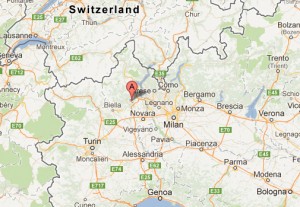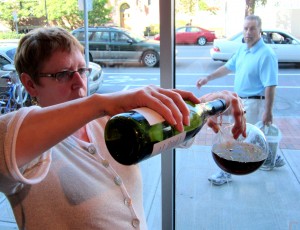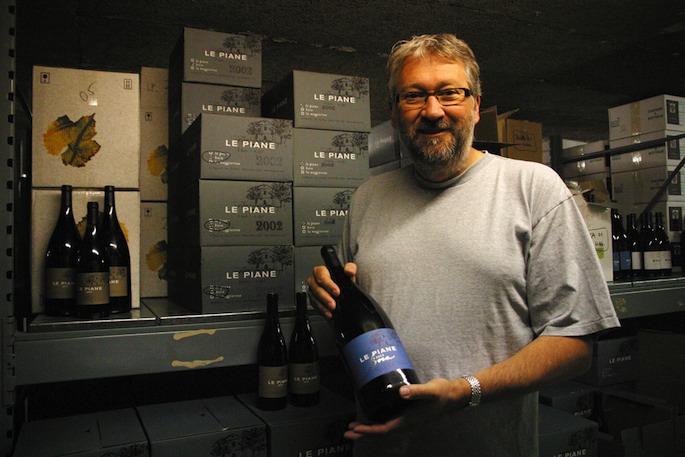THE STORY OF HOW a genial Swiss wine importer named Christoph Künzli undertook the recovery of the Boca vineyards in Italy’s Piedmont region when they were on the verge of extinction has been told before. It’s a story that should be better known, in part because it is so frankly heartwarming, in part because to know about these wines and have a connection to a source for them is to give yourself the great pleasure of being able to drink them.
Briefly, Künzli encountered Boca and its plight in the late 1980’s when the region was in dire straits, most of the vineyards having long since reverted to forest. Less than 10 hectares (25 acres) of viable vineyards remained, among them a tiny parcel called Campo delle Piane owned by Antonio Cerri, then in his eighties.
Künzli , his then business partner, and more than a hundred wine-loving investors bought the property from the octogenarian. In the intervening years, the property now known as Le Piane (“lay-pee-AH-nay”) has expanded to about 7 hectares (17 acres), new vineyards have been planted and older ones carefully curated. Künzli was in Boston last week, visiting retail shops and sampling his wines with Massachusetts distributor, Adonna Imports.

Boca shares some important features with the DOCG wines of Barolo and Barbaresco, the elite red wines of the region. Both employ nebbiolo, a variety that has been important here since Roman times (first century Roman naturalist Pliny the Elder mentions it). However, the law requires wines bearing the Boca DOC to blend in a percentage of vespolina and bonarda – varieties with much less cachet.
The fact that Boca’s are blended wines is enough to constitute something of a stumbling block for those who hold the view that a true expression of terroir can only occur when a single grape variety is matched with a single parcel of ground, and prompt unfavorable comparisons with wines that are 100% nebbiolo.
The notion that a single varietal wine is – other factors being more or less equal – always going to prove a more authentic wine than a blend may stem from an idealized model of how progress in winemaking unfolds. Inspiration for the belief is surely provided by Burgundy where a thousand years of trial and error resulted in the marriage of a sole white (chardonnay) and a sole red (pinot noir) with specific vineyards to produce famously spectacular results.
But because such an arrangement has been successful in one place is no guarantee it’s the best way to proceed in another. This is especially true if winegrowers lack the abundant resources (deep reserves of capital, vast vineyard holdings, acres of cellars, a long literate, institutional memory) required to wed a single varietal to its perfect patch of ground.
Among vignerons lacking such resources – and this has to mean the great mass of same, everywhere, over the centuries – a much more cautious approach prevailed. It involved cultivating a selection of grapes whose specific qualities varied in such a way as to make them complimentary and thereby provide a modicum of risk mitigation. For example, you might lose your late ripening grapes to an end-of season hailstorm, but your earlier ripening crop would have already been brought safely into the cellar.

Historically, variety in the vineyard may have first been regarded as a hedge against disaster – shall we call it peasant conservatism? – but it soon must have become apparent that judicious blending was also a way for the smallholder to get a better price for his wine. Having a bit of something soft and juicy on hand to offset the hard edge of more acidic or tannic wine was just good business and helped you ride out difficult vintages. Savvy winegrowers must have learned this very early on.
The classic example is surely Bordeaux, whose wine trade was already going great guns in the 12th century. There, merchants counted on blending techniques to provide a consistent version, vintage-to vintage, of the claret the English market so adored. Blending was increasingly seen as the primary value shippers contributed to the sales chain since only they could afford to keep stocks of individual wines for the purpose (shall we call it commercial conservatism?).
In this scenario, where an individual wine came from mattered less than the contribution it was able to make to the finished product. The negociant’s name, rather than a producer or vineyard, was the thing you put your money down on.
A shift to estate bottling over the last 40 years or so (thank marketing genius Alexis Lichine) has changed this picture somewhat – but varietal blending still rules. If Burgundy is held in higher overall esteem today than Bordeaux, it is in part because as a varietally unblended wine it is perceived as something purer and less manipulated and thereby more expressive of terroir.
Künzli has some concern that since neither vespolina nor bonarda is considered the quality equal of nebbiolo, including them diminishes the prestige of Boca DOC wine. “Today, it’s single vineyard and single varietal wines that are the fashion,” Künzli says while pouring wine for those queuing for a taste of Le Piane at Cambridge’s Central Bottle recently. “But if terroir comes with the vineyard then it comes with every grape from the vineyard, not just nebbiolo.”
The observation seems like a a fair one, especially since at Le Piane the blending is actually being done in the vineyard – not in some Champagne- style post-vinification assemblage. In fact, one might almost say that the blending is being done by the vineyard since vines of these different varieties grow helter-skelter in the same plot of ground, their grapes are all harvested at once and vinified together (not as separate lots) in the same proportions in which they existed in the field.
Today, single vineyard and single varietal wines are the fashion . . . but if terroir comes with the vineyard then it comes with every grape from the vineyard, not just nebbiolo.
If Künzli’s intuition that a field blend (as these are often called) may be an even MORE powerful transmitter of the mysterious thing called terroir than single varietal wine puts him out on a limb, he’s got excellent company. At Domaine Marcel Deiss in Alsace, Jean-Michel Deiss has been practicing co-plantation and co-fermentation for years now, motivated in part by a desire to demonstrate conclusively that vineyards of exceptional character will always trump varietal character if given half a chance.
I became a believer in the Deiss Doctrine ten years ago at a comprehensive tasting of the domaine’s wines conducted by the then Madame Deiss. Sure, there’s plenty of criticism of the practice – almost entirely be people whose wine is nowhere near as good.
It’s not as if vespolina is a dreamboat to work with. Künzli complains that the grape is a cranky one, difficult to grow and sensitive to wet weather. But he likes what it contributes in Boca’s higher altitude vineyards where nebbiolo becomes a more airy and delicate thing than in the Langhe Hills further south and benefits from some of what Künzli calls “a little filling out.”
“A hundred years ago they were blending a little barbera into Barolo to get more body. Why not blend them if the result is better?”
Notes from Le Piane tasting June 18, 2012
La Maggiorina 2010 Fully dry, lightish bodied red showing lovely bright cherry-like fruit and some assertive herbal notes said to be characteristic of the vintage. Easy-going texture; cheery, easy drinking, versatile little red . 50% nebbiolo, 40% vespolina. $15
Le Piane Colline Novarese 2008 Brilliant medium ruby hue; bright, high-toned red berry fruit aromas; palate is quite dry and lightly textured with bright red fruit and some pleasing notes of loamy earth. 100% croatina. $36
Le Piane Boca 2004 Color reminiscent of faded red rose petals. Very lively and fresh acidity here with fruit that is both delicate and subtly forceful. Lightly balsalmic with elements of spruce and juniper. Lightly grippy texture. Elegant and a bit aloof. $60
Le Piane Boca 2006 A deeper, more profound coloration ’04 with more garnet aspects and fewer brown/orange tints. Rather vivid aromas of black cherry; plenty of acid here. A wine of more substance and vigor than ’04, but perhaps not quite as complex or elegant; firm, grippy texture. $60
Campo delle Piane 1990 Rather modest in the aroma department but comes vividly alive on the palate; distinctly crisp, forthright dark red fruits tinged with cedar, spruce, and a balsalmic note. Not a lot of length but surprisingly brisk on the attack and steady on the mid-palate. Plenty of life left in this wine. She’s lively yet. $68
